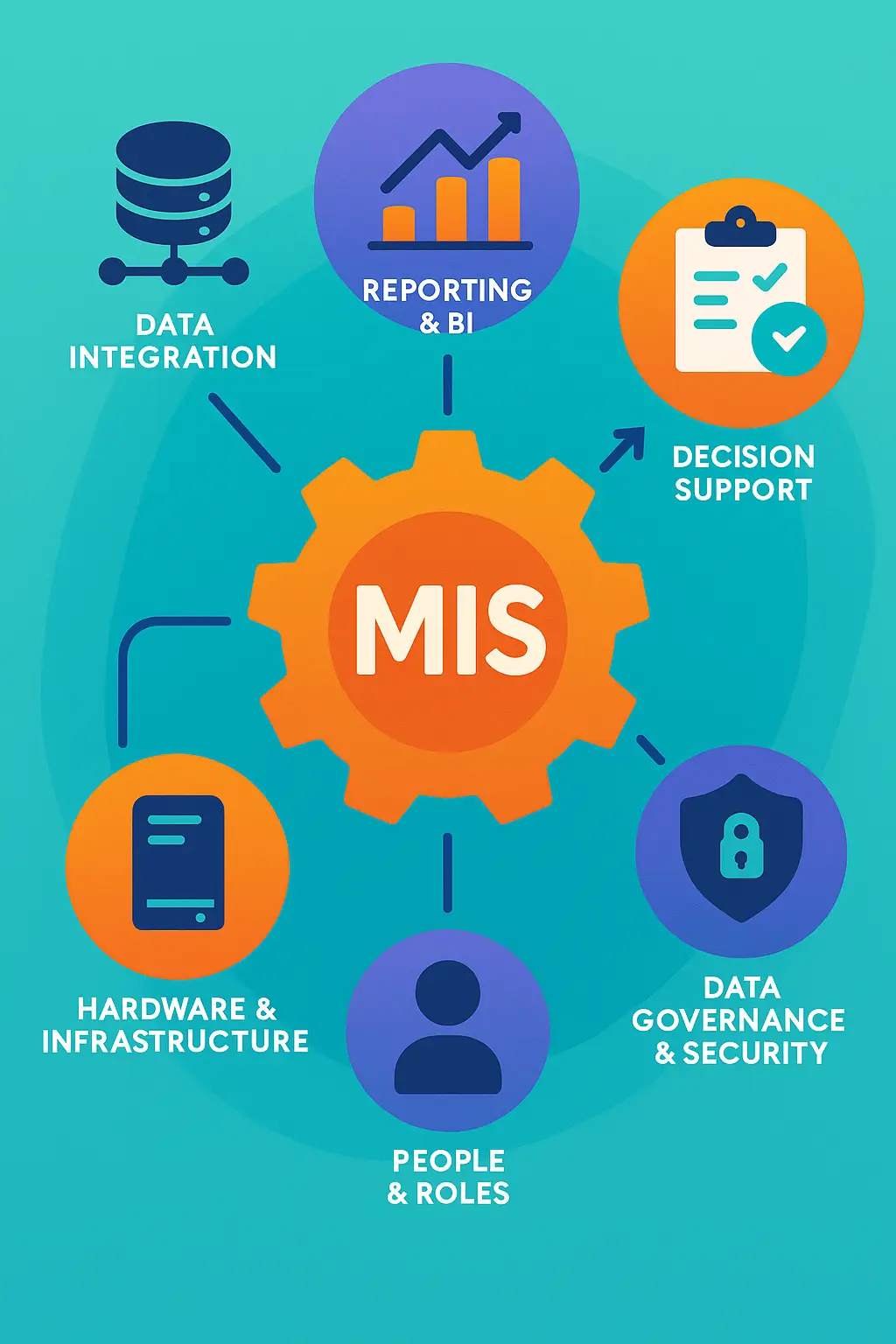Introduction
In an era of abundant data and rapid change, organizations need reliable systems to collect, process, and present information for decision-makers. A Management Information System (MIS) does exactly that: it ties together people, processes, and technology to deliver timely insights. This article explores MIS fundamentals, benefits, implementation guidelines, and its role in marketing and other business functions.
What Is a Management Information System?
A Management Information System is an integrated set of components—hardware, software, data, procedures, and people—designed to gather, process, store, and distribute information. Unlike transactional systems that record day-to-day operations, MIS focuses on aggregating data, generating reports, and supporting mid- to long-term planning. Key characteristics include:
- Data Integration: Pulling data from various sources (CRM, ERP, web analytics) into a unified repository.
- Reporting & Analysis: Producing standardized and ad-hoc reports, dashboards, and alerts for managers.
- Decision Support: Enabling trend analysis, forecasting, and “what-if” scenarios to guide strategic choices.
Core Components of MIS
- Hardware & Infrastructure: Servers, network devices, and storage that host databases and applications.
- Software Applications:
- Database Management Systems (DBMS): Store and retrieve structured data.
- Reporting Tools & BI Platforms: Tools like Power BI, Tableau, or similar for visualization.
- Enterprise Applications: ERP or CRM modules feeding data into MIS.
- Data: Clean, validated, and timely data drawn from internal systems (sales, finance, operations) and, when relevant, external sources (market data, social listening).
- Procedures & Policies: Defined workflows for data entry, validation, report generation, access controls, and data governance.
- People & Roles:
- IT/Systems Team: Maintains infrastructure, ensures security, integrates data sources.
- Data Analysts/Engineers: Clean, transform, and model data; build dashboards.
- Business Users/Managers: Define requirements, interpret reports, and act on insights.
- Executive Sponsors: Champion MIS initiatives, allocate resources, oversee governance.
Benefits of an Effective MIS
- Timely Insights: Automated reports and dashboards deliver up-to-date performance metrics, reducing manual effort.
- Improved Decision Quality: Consolidated data and analytical tools support evidence-based planning, budgeting, and forecasting.
- Operational Efficiency: Streamlined information flows eliminate silos; standardized procedures reduce errors.
- Scalability: As data volumes grow, a well-designed MIS can scale to accommodate new data sources or users.
- Cross-Functional Alignment: Shared metrics and unified dashboards foster collaboration among marketing, finance, operations, and other teams.
MIS in Marketing
Marketing relies heavily on data: customer behavior, campaign performance, market trends, and ROI metrics. MIS enhances marketing by:
- Centralized Dashboards: Integrate CRM data (lead sources, conversion rates), web analytics (traffic, engagement), and sales figures to offer a 360° view.
- Segmentation & Targeting: MIS can process customer attributes and behavior to inform segmentation, enabling personalized campaigns.
- Campaign Tracking & Optimization: Real-time or periodic reports show which channels, creatives, or offers perform best, guiding budget allocation.
- Forecasting & Planning: Historical data helps project future demand, plan new product launches, or adjust seasonality-driven campaigns.
- Cross-Functional Visibility: Marketing insights feed into inventory planning, finance forecasts, and supply-chain coordination to align operations with demand signals.
Implementation Steps
- Assess Needs & Define Objectives: Engage stakeholders to identify key questions MIS should answer (e.g., “Which customer segments drive highest lifetime value?” or “How do promotional campaigns affect sales weeks later?”).
- Inventory Data Sources: List internal systems (ERP, CRM, web analytics, social platforms) and potential external feeds (market reports, demographic data). Evaluate data quality and integration effort.
- Choose Technology Stack: Select a scalable database (data warehouse or data lake), ETL/ELT tools for data integration, and BI/reporting platforms aligned with budget and user skill levels. Consider cloud-based solutions for flexibility.
- Design Data Architecture & Governance: Establish schemas, naming conventions, data definitions, and access controls. Define roles for data ownership and stewardship.
- Develop Reports & Dashboards Iteratively: Start with high-priority reports for core KPIs. Use an agile approach: gather user feedback, refine visualizations, and expand gradually to more advanced analytics.
- Train Users & Promote Adoption: Provide training sessions and documentation. Highlight quick wins (e.g., time saved on manual reporting) to encourage usage.
- Monitor Performance & Maintain System: Regularly review data pipelines for accuracy, optimize query performance, handle evolving requirements, and manage user access.
- Iterate & Scale: As the organization grows, incorporate new data sources (e.g., IoT, social listening), add predictive analytics or AI-driven insights, and refine governance to maintain data integrity.
Challenges and Solutions
- Data Silos & Quality Issues: Disparate systems may store inconsistent or incomplete data. Solution: Implement robust ETL processes, data validation rules, and a master data management approach.
- User Resistance: Teams may resist new tools or workflows. Solution: Involve users early, demonstrate clear benefits, and provide hands-on training.
- Resource Constraints: Limited budget or skilled personnel can hinder MIS projects. Solution: Prioritize high-impact use cases, consider cloud/managed services, and upskill existing staff with targeted training.
- Security & Compliance: Sensitive data must be protected and comply with regulations (GDPR, etc.). Solution: Enforce role-based access, encryption at rest/in transit, and audit logging; establish clear data retention policies.
- Scalability & Performance: As data volume grows, queries may slow. Solution: Architect with scalable storage (e.g., data warehouse in the cloud), optimize indexing, and employ data partitioning or caching where appropriate.
Emerging Trends
- Cloud-Based MIS & Data Warehousing: Migration to cloud platforms (Snowflake, BigQuery, Azure Synapse) for flexibility, cost-efficiency, and easier scaling.
- Advanced Analytics & AI Integration: Embedding predictive models and machine-learning insights into MIS dashboards for churn prediction, demand forecasting, or customer lifetime value scoring.
- Self-Service BI: Empowering business users with intuitive tools to build their own reports, reducing reliance on IT for every query.
- Real-Time Data Processing: Streaming analytics for immediate insights (e.g., real-time campaign performance), enabling faster responses.
- Data Democratization & Collaboration: Enhanced collaboration features in BI tools, social annotations, and shared dashboards to foster data-driven culture.
Best Practices
- Start with Clear Use Cases: Focus on solving concrete business problems to demonstrate value early.
- Maintain Data Governance: Regular audits, data quality checks, and clear ownership to ensure reliability.
- Adopt Agile Development: Release reports and features in small increments, gather feedback, and iterate.
- Foster a Data-Driven Culture: Encourage decision-makers to reference MIS insights; celebrate successes driven by data-informed actions.
- Ensure Ongoing Training: As tools evolve, provide refresher sessions and share best practices across teams.
Conclusion
A well-implemented Management Information System is a cornerstone of modern organizations, enabling timely, data-driven decisions that improve efficiency and competitive advantage. By understanding MIS components, aligning them with strategic objectives—particularly in marketing—and following best practices for implementation and governance, businesses can unlock deeper insights and adapt swiftly to changing markets.

